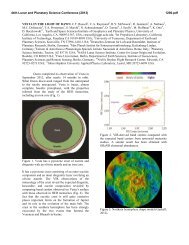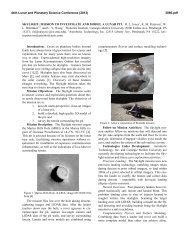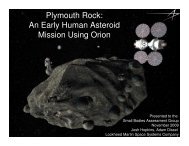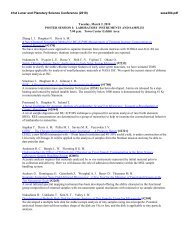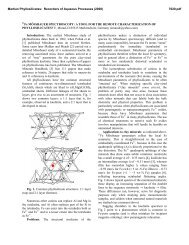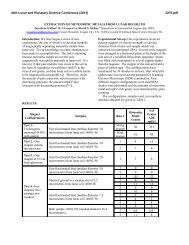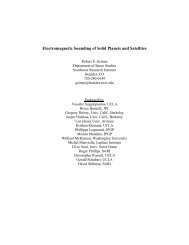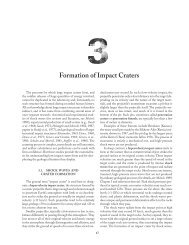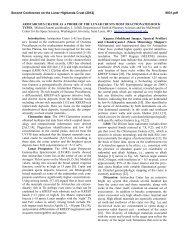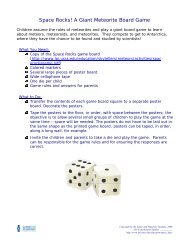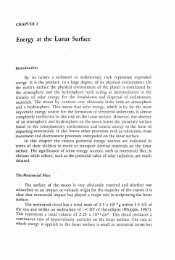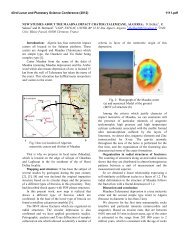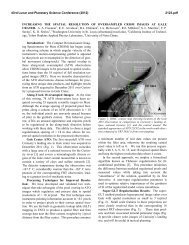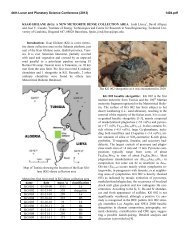Jupiter System Observer Mission Study: Final Report - Lunar and ...
Jupiter System Observer Mission Study: Final Report - Lunar and ...
Jupiter System Observer Mission Study: Final Report - Lunar and ...
Create successful ePaper yourself
Turn your PDF publications into a flip-book with our unique Google optimized e-Paper software.
01 NOVEMBER 2007 2007 JUPITER SYSTEM OBSERVER MISSION STUDY: FINAL REPORT<br />
SECTION 4—MISSION CONCEPT IMPLEMENTATION Task Order #NMO710851<br />
For purposes of quantifying the amount of<br />
science return from a typical encounter,<br />
st<strong>and</strong>ard science data quanta have been<br />
defined. Since the LA <strong>and</strong> GPR are limited to<br />
close-range operation, we have assumed that<br />
each operates for 800 s near closest approach,<br />
during which time the LA will generate 10 Mb<br />
of data <strong>and</strong> the GPR will generate 240 Mb. For<br />
the remote sensing instruments, the quantum<br />
chosen is a data set for which each instrument<br />
generates spatial coverage in a square whose<br />
height is equal to its cross-track swath width.<br />
For the spectrometers, full spectral coverage is<br />
obtained over this spatial frame yielding a<br />
st<strong>and</strong>ard spectral cube for each spectrometer.<br />
For the MRC used in stereo, a stereo pair of<br />
frames is assumed. Modest levels of data<br />
compression (or editing or summing) are<br />
assumed for each instrument except the VHS,<br />
which must reduce its data in real-time internal<br />
Instrument<br />
4-50<br />
to the instrument by a factor of 100. The<br />
remote sensing st<strong>and</strong>ard data quanta are<br />
summarized in Table 4.5-4, <strong>and</strong> the<br />
overlapping FOVs for the various remote<br />
sensing instruments in such a data quantum are<br />
shown in Figure 4.5-2.<br />
The encounter strategy, shown schematically<br />
in Figure 4.5-3, is to begin with an<br />
empty SSR <strong>and</strong> a fully charged battery. The<br />
MAG <strong>and</strong> PS/EPD run 100% of the time. The<br />
LA <strong>and</strong> GPR run for 800 s around closest<br />
approach. These four instruments collect<br />
380 Mb of data during the encounter period.<br />
The remaining 17.2 Gb of capability per<br />
encounter is used to return remote sensing<br />
data. This data volume corresponds to 149<br />
remote sensing quanta. These remote sensing<br />
frames or cubes can be used in a wide variety<br />
of ways including regional-scale mapping <strong>and</strong><br />
high-resolution targets. Figure 4.5-4 summa-<br />
Table 4.5-4. St<strong>and</strong>ard Remote Sensing Data Quanta<br />
Cross-track<br />
spatial pixels<br />
Along-track<br />
spatial pixels<br />
Spectral (or<br />
stereo)<br />
channels Bits/pixel<br />
Compression<br />
factor<br />
Data Volume<br />
(Mb)<br />
HRC 2048 2048 1 12 4 12.6<br />
MRC (stereo) 2048 2048 2 12 4 25.2<br />
VHS 480 480 1350 12 100 38<br />
UVS 64 64 1024 12 3 17<br />
TS 32 32 2800 16 2 23<br />
Total 115.8<br />
Figure 4.5-2. Overlapping FOVs of st<strong>and</strong>ard remote sensing quantum. The MRC FOV is<br />
10 larger than that of the Hires FOV <strong>and</strong> is not shown here.



